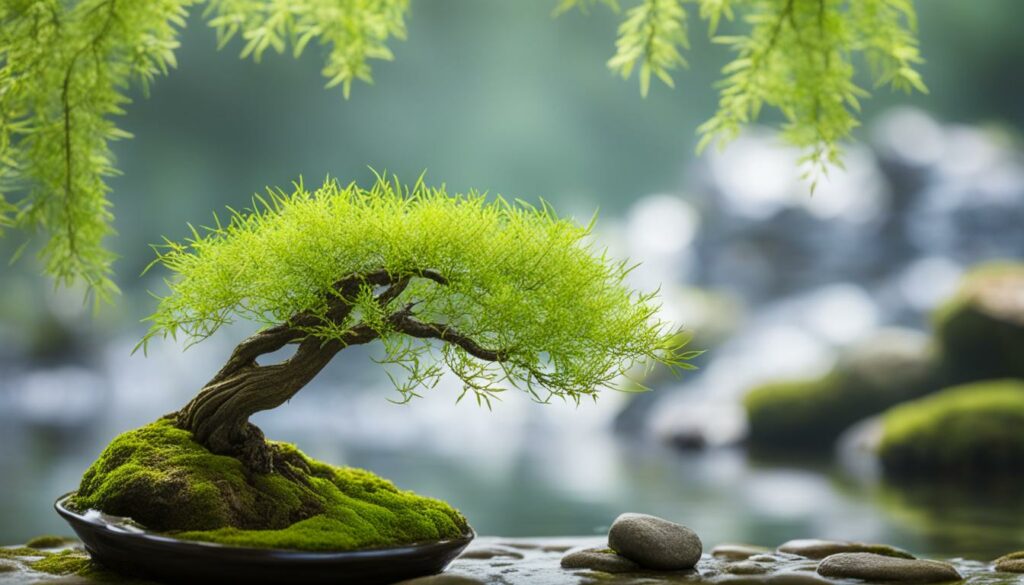Welcome to the world of Bonsai Tree Species Willow, where the delicate and weeping nature of these trees bring grace and beauty to your garden. The Willow Bonsai is a water-loving tree species that has become a popular choice among bonsai enthusiasts, thanks to its unique characteristics that set it apart from other bonsai trees.
Key Takeaways:
- Willow Bonsai is a water-loving tree species that brings grace and beauty to any garden.
- The delicate and weeping nature of Willow Bonsai sets it apart from other bonsai trees.
- Due to its popularity, Willow Bonsai is widely available for purchase and cultivation
- Proper care and maintenance are crucial for the health and beauty of Willow Bonsai.
- Displaying and showcasing Willow Bonsai can be done in various ways to enhance the aesthetics of your garden.
An Introduction to Willow Bonsai
Bonsai Tree Species Willow, also known as Willow Bonsai, is a popular choice among bonsai enthusiasts. These trees are known for their delicate, weeping nature, which makes them a unique and captivating addition to any garden.
Willow Bonsai originated in China and Japan, where they were cultivated for their medicinal properties. Over time, these trees have become highly valued for their aesthetic appeal as well.
One of the most unique features of Willow Bonsai is their water-loving nature. These trees require a consistently moist environment to thrive, making them ideal for those who enjoy the peaceful sound of running water in their gardens.
When cared for properly, Willow Bonsai can live for many years, developing into stunning works of art. Their weeping form lends itself to a variety of shaping and pruning techniques, allowing bonsai artists to create unique and visually striking designs.
Explore the fascinating world of Willow Bonsai and discover how you can elevate your gardening art with these graceful trees.

Cultivating Willow Bonsai
If you’re interested in cultivating water-loving bonsai trees, Willow Bonsai could be the perfect choice for you. Bonsai Tree Species Willow thrives in moist soils like those near streams, ponds, and other bodies of water. Follow these specific care requirements and techniques to keep your Willow Bonsai healthy and beautiful:
Soil and Watering
The ideal soil for Willow Bonsai is a mixture of peat moss, sand, and perlite. It should have good drainage to prevent waterlogging, which can be detrimental to the tree’s health. Water your Willow Bonsai daily, allowing the soil to dry out partially and never completely. Overwatering can cause root rot and may kill the tree.
Fertilizing
Apply a fertilizer to your Willow Bonsai every two weeks during the growing season, from early spring to autumn. Nitrogen-rich fertilizer is ideal for this species. Be careful not to over-fertilize, as this may cause excessive growth and lead to root rot.
Temperature and Humidity
Willow Bonsai prefers a cool, moist environment with high humidity levels, ideally between 50% and 85%. Keep the tree away from direct sunlight and drafts, as they can dry out the soil and damage the tree’s delicate foliage.
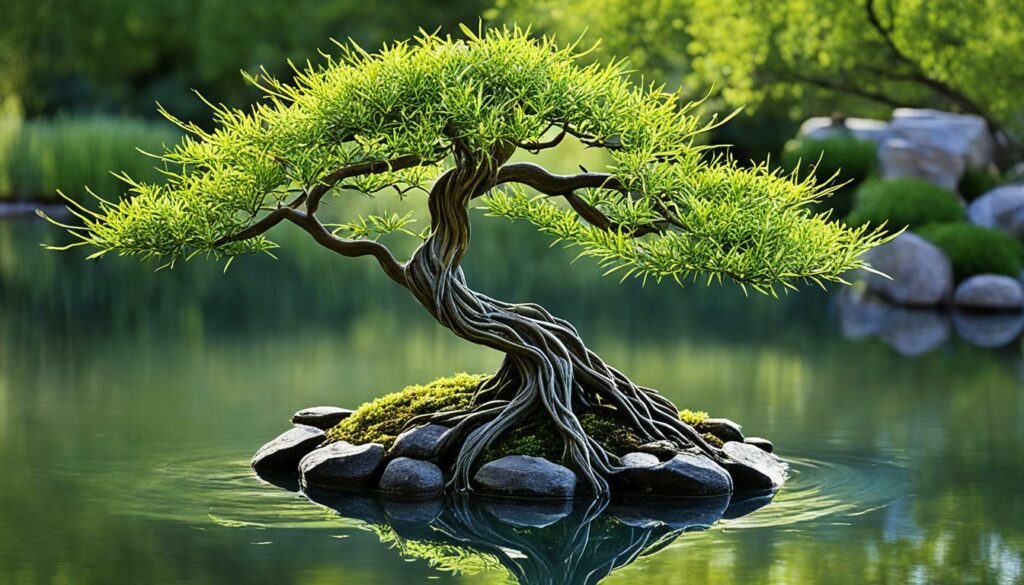
Tip: To maintain proper humidity levels, you can place a tray of water near your Willow Bonsai or use a humidifier to regulate the air moisture.
With proper care and cultivation, your Willow Bonsai tree can become a stunning centerpiece in your garden or home. Make sure to provide the ideal growing conditions for this water-loving bonsai, and it will reward you with its graceful beauty.
Shaping and Pruning Techniques for Weeping Bonsai
Shaping and pruning your Bonsai Tree Species Willow is important to maintain their signature weeping form and promote healthy growth. There are different techniques used to create unique and stunning designs.
One pruning technique is known as the “clip and grow” method, which involves cutting back branches to promote new growth in desired areas of the tree. This technique is particularly useful in shaping willow bonsai, as it allows you to guide the weeping branches in specific directions.
Another popular technique for shaping your weeping bonsai is wire training. This involves wrapping wire around the branches of your tree and bending them into the desired shape. It’s important to be careful not to over-bend or break branches, as this can cause irreparable damage to your tree.
Expert Tip:
When pruning your willow bonsai, use sharp and clean tools to avoid damaging the tree and promote faster healing. Seal larger cuts with pruning paste, which will protect the tree from pests and diseases.
| Technique | Description |
|---|---|
| Clip and grow | Cutting back branches to promote new growth in desired areas of the tree. |
| Wire training | Wrapping wire around the branches of your tree and bending them into the desired shape. |
Remember that shaping and pruning your weeping bonsai is an art form that requires patience and practice. With time, you’ll be able to create stunning designs that showcase the beauty of your Bonsai Tree Species Willow.
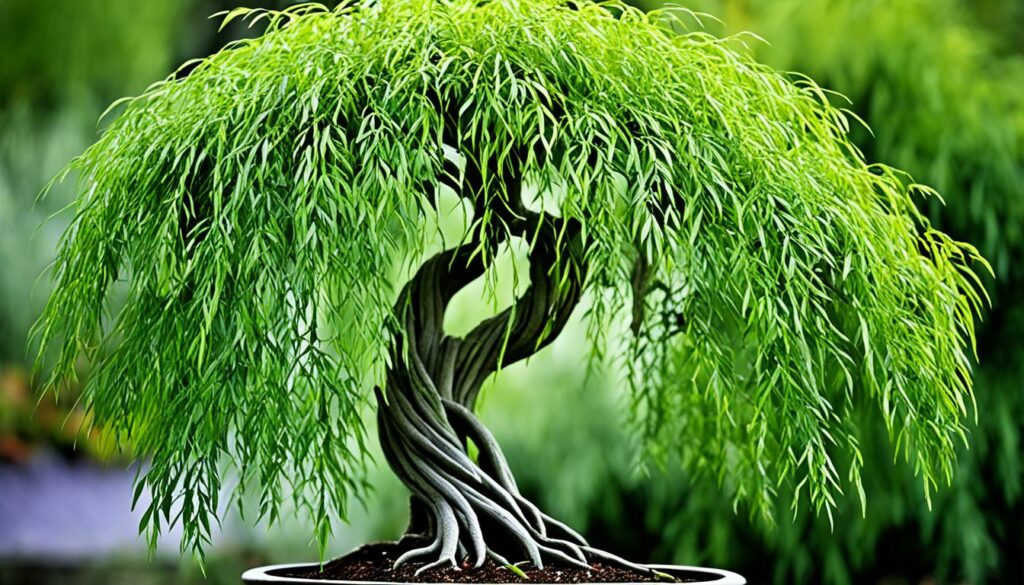
Maintaining the Beauty of Willow Bonsai
Keeping your Willow Bonsai healthy and beautiful requires regular attention and care. Here are some essential steps to help your bonsai thrive throughout its life.
Watering
The water-loving nature of Willow Bonsai requires consistent and frequent watering. Ensure that the soil is moist but not waterlogged. Avoid letting the soil dry out completely, as this can be detrimental to the health of your bonsai.
Expert tip: Using a humidity tray or misting the foliage regularly can help maintain the moisture levels of your Willow Bonsai.
Fertilizing
Regular fertilization is crucial for the growth and development of your Willow Bonsai. Use a suitable fertilizer specific to bonsai trees and follow the instructions carefully.
Pest and Disease Control
Preventing and controlling pests and diseases is essential for the survival of your Willow Bonsai. Regularly inspect the tree for any signs of infestation or disease and take immediate action if necessary.
Expert tip: Using natural pest control methods like neem oil or introducing beneficial insects can help keep your bonsai free from harmful pests.
Pruning and Shaping
Regular pruning and shaping are necessary for maintaining the weeping form and overall beauty of your Willow Bonsai. Use sharp and clean tools, follow the proper techniques, and prune only when necessary.
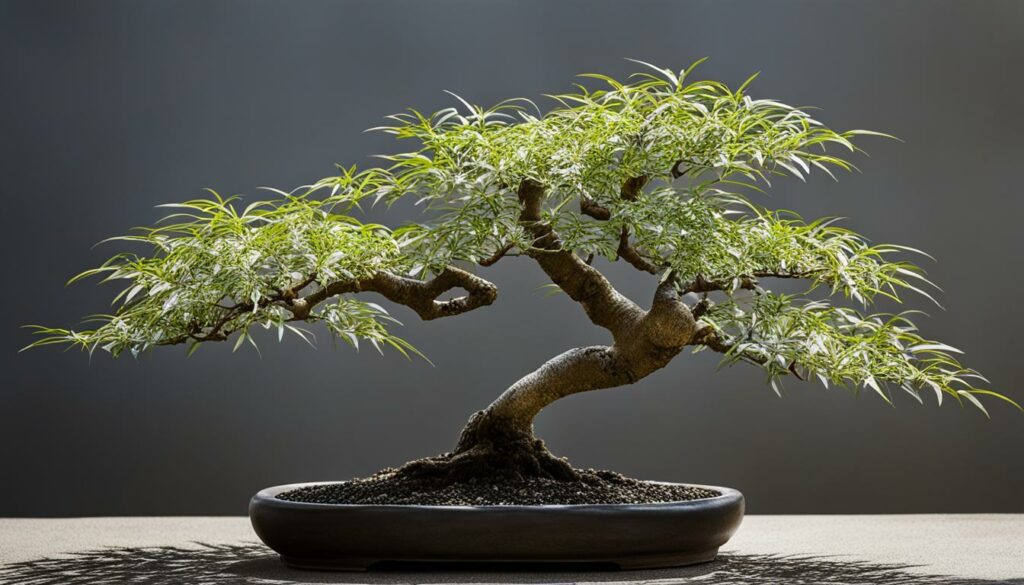
Re-potting
Re-potting your Willow Bonsai every few years is essential for maintaining healthy root growth and development. Follow a proper re-potting technique and use the appropriate soil mix for your bonsai.
Displaying and Showcasing Willow Bonsai
Once you have grown and trained your Willow Bonsai to perfection, it’s time to showcase its beauty in the best possible way. Choosing the right container and accessories can enhance and complement the aesthetics of your bonsai tree, making it the center of attention in any room.
When selecting a container for your Willow Bonsai, consider the size and shape of the tree as well as the container’s overall design. Traditional ceramic pots are a popular choice, but don’t be afraid to experiment with unique and creative options. You can also opt for a wooden container to add a natural element to your display.
Accessories like stones, gravel, and moss can add texture and color to the display, while figurines and other decorative elements can give your bonsai tree a personal touch. Just remember to keep it tasteful and not overcrowd the display with too many accessories.
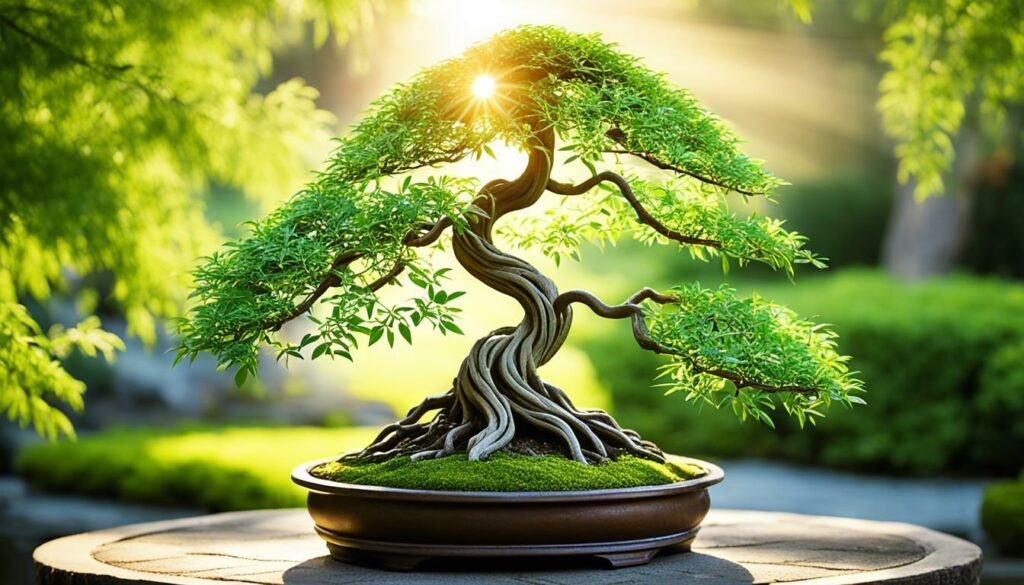
Caring for your Willow Bonsai’s display is as important as caring for the tree itself. Keep the container and accessories clean and dust-free to maintain its pristine appearance. Rotate the tree every few weeks to ensure even sunlight exposure and promote balanced growth.
By selecting the right container and accessories and maintaining its display, you can truly showcase the beauty of your Willow Bonsai and enjoy its graceful presence in any space.
Conclusion
Congratulations on exploring the captivating world of Bonsai Tree Species Willow. In this article, you have learned about the beauty and unique features of Willow Bonsai, as well as the specific care requirements and techniques necessary for cultivation.
By shaping and pruning your weeping bonsai, you can create stunning and unique designs. To ensure the health and beauty of your Willow Bonsai, be diligent in maintaining its watering, fertilizing, and pest control schedule.
Finally, by exploring various containers and accessories, you can showcase the beauty of your Willow Bonsai and enhance its overall aesthetics.
Thank you for joining us on this journey through the world of Bonsai Tree Species Willow. We hope this article has inspired you to elevate your gardening art with the delicate, weeping nature of this water-loving bonsai.
FAQ
What is Willow bonsai?
Willow bonsai refers to a specific type of bonsai tree species that belongs to the Willow family. It is characterized by its graceful and weeping branches, which create an elegant and serene look. Willow bonsai trees are known for their love of water and their ability to thrive in moist conditions.
Why are Willow bonsai trees popular among bonsai enthusiasts?
Willow bonsai trees are popular among bonsai enthusiasts due to their unique and charming appearance. The weeping branches create a sense of tranquility and bring a touch of elegance to any setting. Additionally, these bonsai trees are relatively easy to cultivate and care for, making them a suitable choice for beginners and experienced gardeners alike.
What are the specific care requirements for water-loving bonsai?
Water-loving bonsai, such as Willow bonsai, have specific care requirements to ensure their health and vitality. They thrive in moist conditions, so it’s important to keep the soil consistently moist but not waterlogged. Regular watering, using methods such as soaking or misting, is essential to maintain proper hydration. It’s also crucial to provide adequate drainage to prevent root rot. Additionally, placing the bonsai in a location with high humidity levels can promote optimal growth.
How can I shape and prune my weeping bonsai tree?
Shaping and pruning are essential techniques in maintaining the weeping form of a Willow bonsai tree. To shape the bonsai, you can use wire to gently guide the branches into the desired position, keeping in mind the natural growth pattern of the tree. Pruning should be done during the dormant season to promote healthy growth. Trimming back the branches helps maintain the tree’s delicate form and encourages the development of new buds.
How can I ensure the beauty and health of my Willow bonsai tree?
Ensuring the beauty and health of your Willow bonsai tree requires attention to several factors. Proper watering, regular fertilization, and providing sufficient sunlight are essential. It’s important to monitor the moisture levels of the soil and adjust watering accordingly. Fertilizing with a balanced bonsai-specific fertilizer helps provide the necessary nutrients. Additionally, protecting the bonsai from pests and diseases, such as aphids or fungal infections, is crucial. Regular inspection and prompt treatment are key components of maintaining the beauty and health of your bonsai.
What are some ways to display and showcase my Willow bonsai tree?
There are numerous ways to display and showcase your Willow bonsai tree. One popular option is using traditional bonsai pots or ceramic containers specifically designed for bonsai cultivation. These containers enhance the aesthetic appeal of the bonsai and provide a stable base. You can also explore displaying your bonsai on a bonsai stand or within a miniature landscape, known as a bonsai tray or “saikei.” Additionally, participating in bonsai exhibitions or local bonsai clubs allows you to showcase your creations and gain valuable feedback from fellow enthusiasts.
